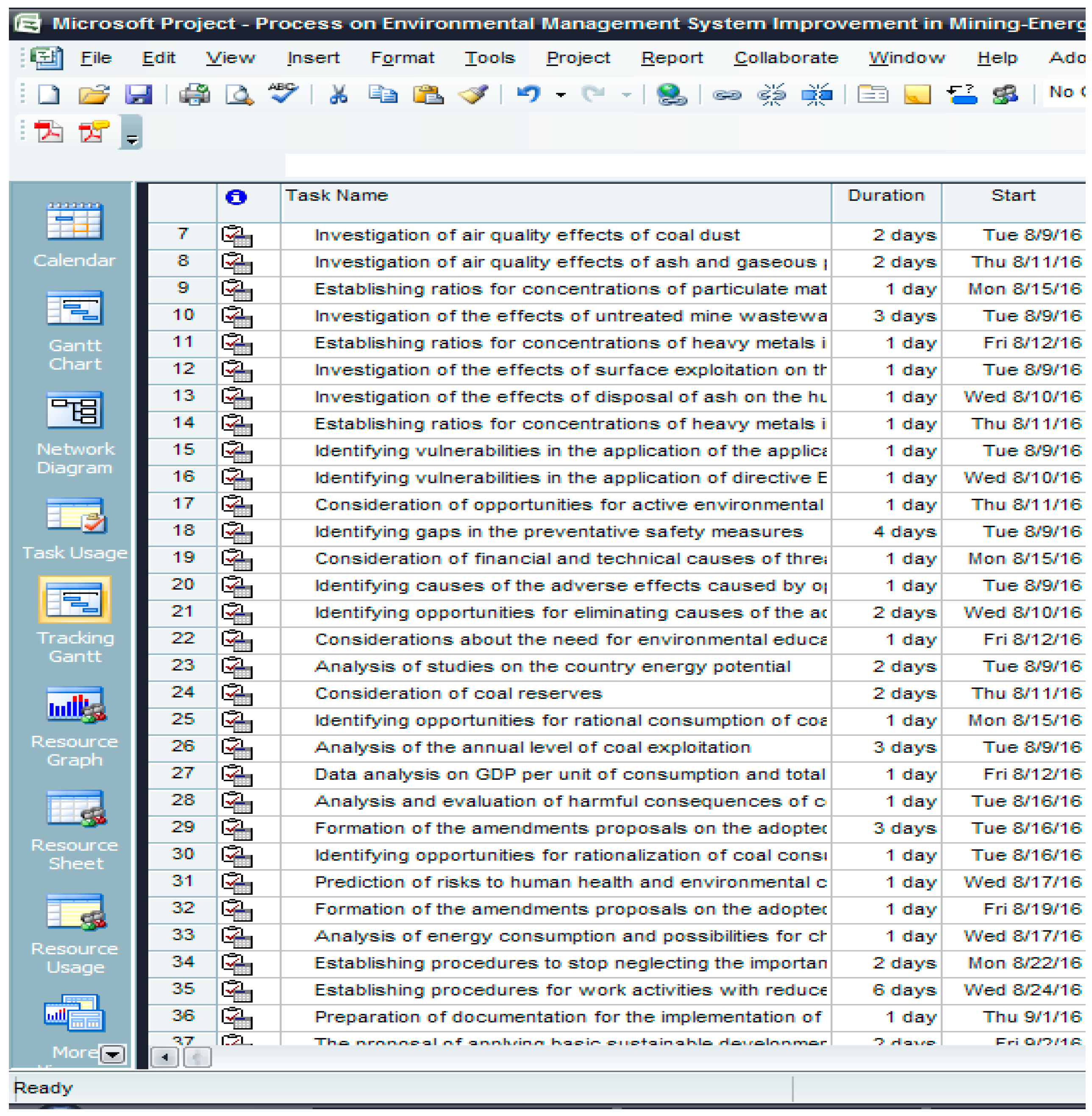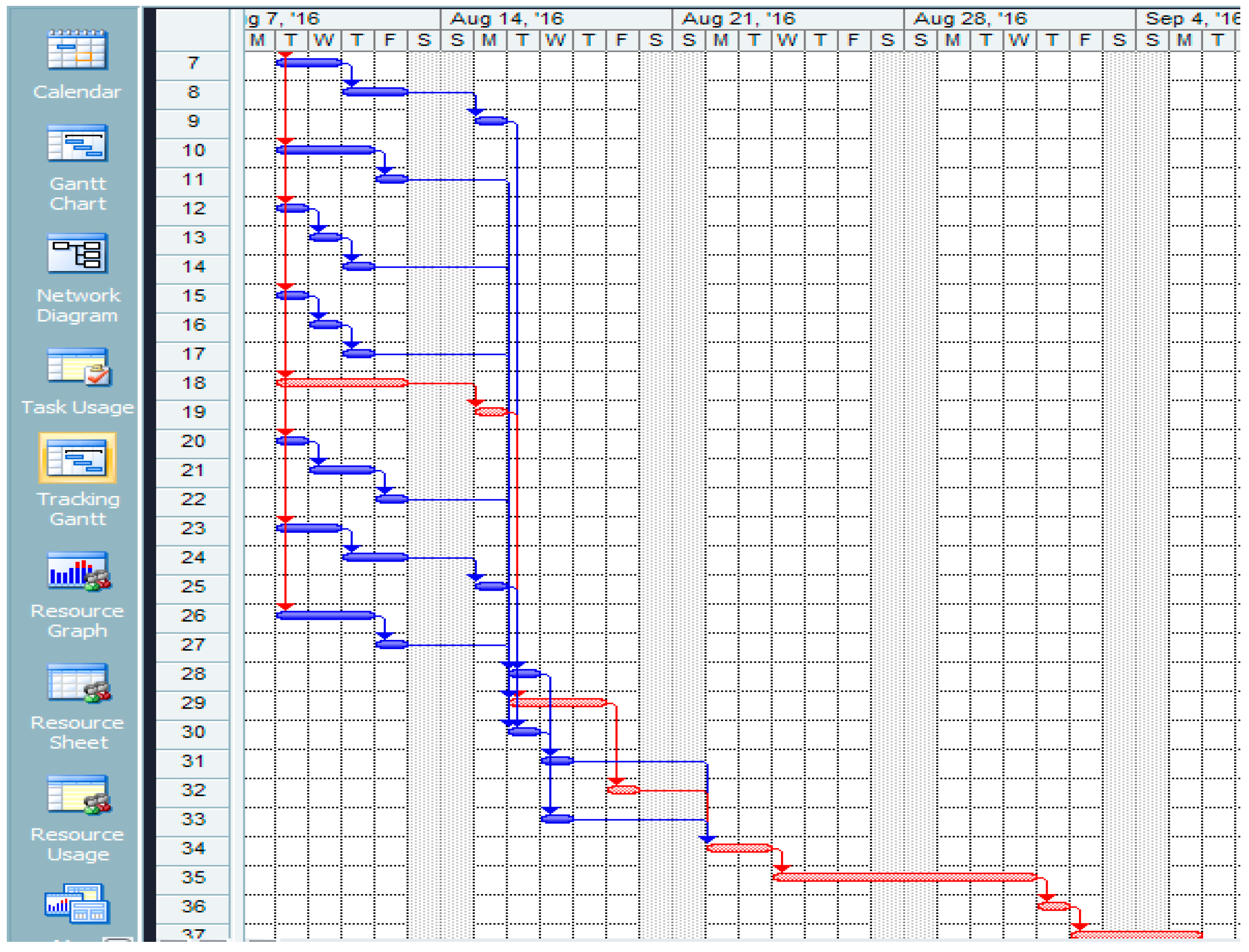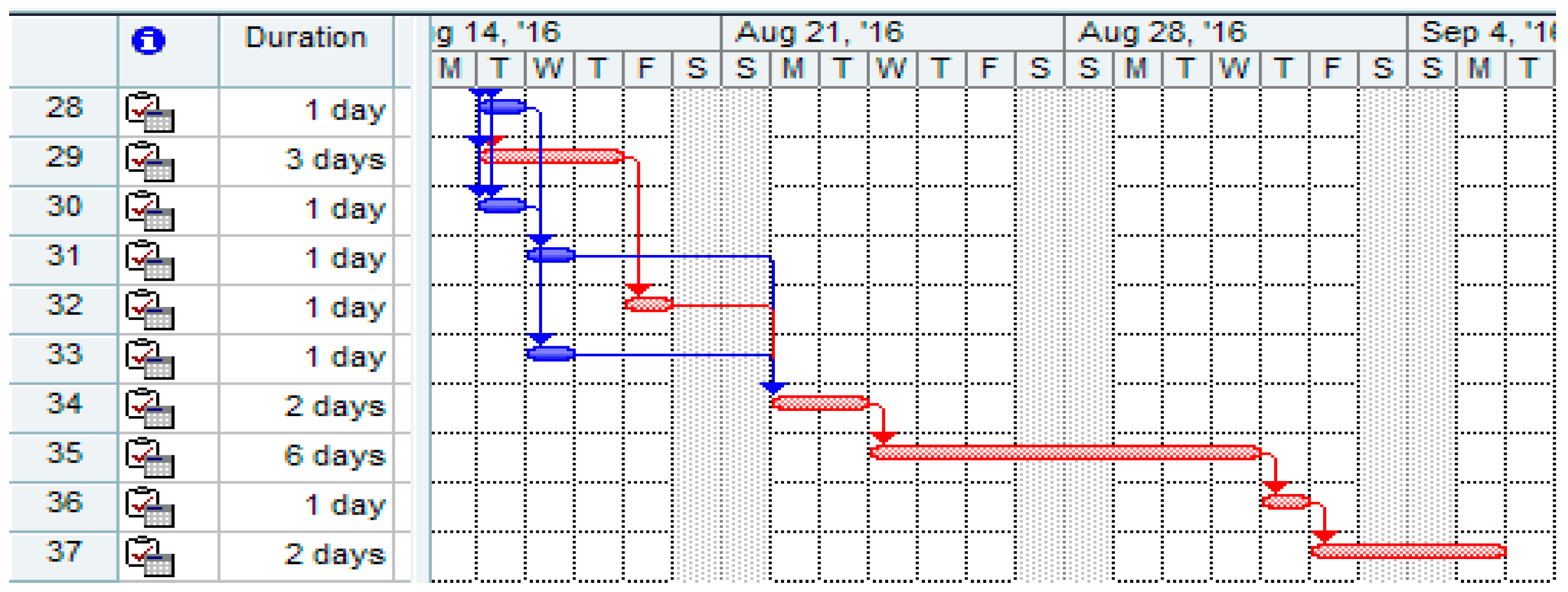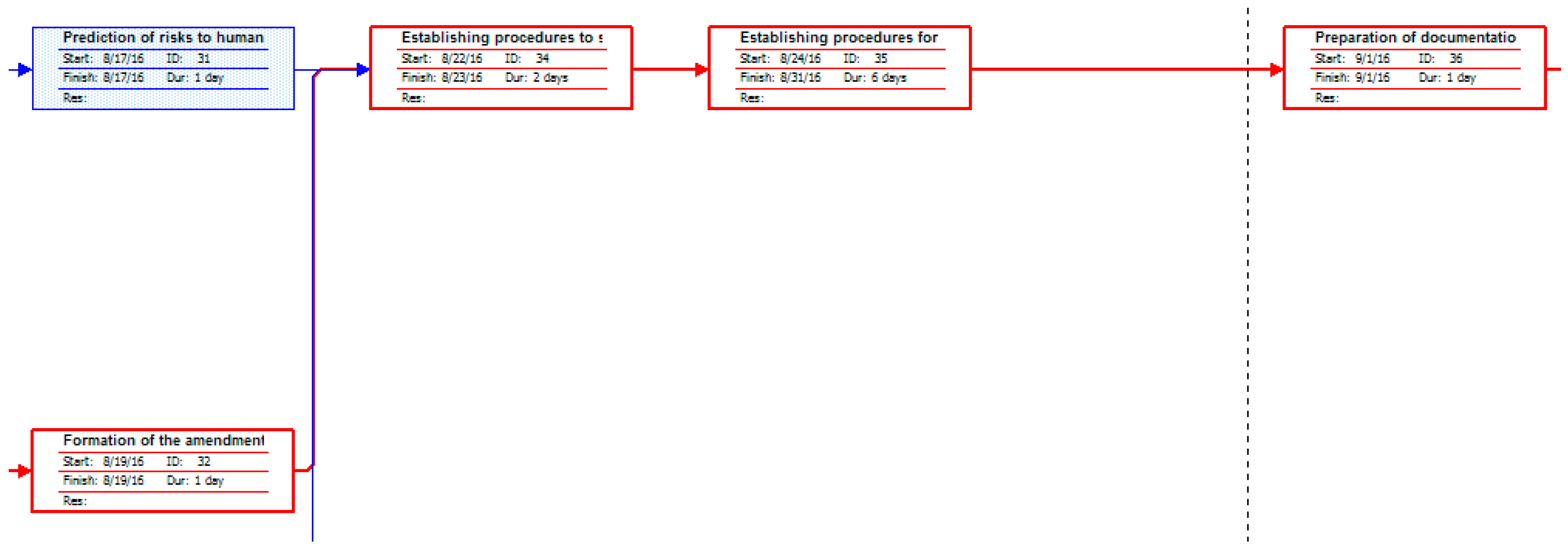Application of Project Management Process on Environmental Management System Improvement in Mining-Energy Complexes
Abstract
:1. Introduction
- environmental basis;
- potential impacts prediction;
- mitigation measures; and
- monitoring risk-based approach to environmental management rely on consideration of;
- hazard identification (in sense of likelihood);
- exposure assessment (in sense of importance); and
- risk characterization.
2. Indicators of Sustainable Development and Their Application in the Energy Sector
- real GDP per unit of energy consumption;
- net energy imports as a percentage of commercial energy consumption; and
- total carbon dioxide emissions per capita and per real GDP unit [7].
- examine and assess the adverse effects of the energy transformation on the environment;
- anticipate environmental risks;
- eliminate the causes of threats to the environment;
- establish an ethical attitude towards the environment and make rational use of natural resources;
- develop ecological ethics; and
- develop a consumer behavior, i.e., take into account the impact of the transformation of energy on the environment.
3. Project Management Process for Improving Environmental Protection by Applying a Network Planning Technique
- Is the aspect regulated by the law and is coal mining and combustion suspended if legal requirements are not adhered to?
- Is the aspect connected to air quality?
- Is the aspect connected to water quality?
- Is the aspect connected to soil quality?
- Is the aspect connected to cross-border pollution?
- Is the aspect connected to direct negative impact on human health?
Network Planning Technique—Critical Path Method (CPM)
4. Conclusions
- Prediction and prevention of risk events with adverse effects are significant for a successful concept of environmental quality management. Therefore, it is necessary to develop a model of environmental quality management that would recognize all of the complexity of interactions within mining and energy complexes and the environment.
- Environmental aspects related to interactions within mining and energy complexes should be organized by use of a suitable model (DPSIR, PSR, DSR, FDES, etc.) and ranked. This leads to the formation of a basis of activities that will be organized by the project management process.
- Based on the survey results, we can propose the project management process elaborated through Critical Path Method as a suitable model for the environmental management system improvement in mining and energy complexes.
- Special care should be given to the environmental aspect identification, evaluation, and ranking as to the activities that belong to the critical path.
Acknowledgments
Author Contributions
Conflicts of Interest
References
- Pokimica, N. National Environmental Approximation Strategy for the Republic of Serbia. Ministry of Environment, Mining and Spatial Planning. Available online: http://www.misp-serbia.rs/wp-content/uploads/2010/05/EAS-Strategija-ENG-FINAL.pdf (accessed on 31 May 2016).
- Djukanovic, M. Sustainable Development and the Environment; Elit: Belgrade, Serbia, 1996. (In Serbian) [Google Scholar]
- Máca, V.; Melichar, J. The Health Costs of Revised Coal Mining Limits in Northern Bohemia. Energies 2016, 9, 81. [Google Scholar] [CrossRef]
- Olías, M.; Nieto, J.M. Background Conditions and Mining Pollution throughout History in the Río Tinto (SW Spain). Environments 2015, 2, 295–316. [Google Scholar] [CrossRef]
- World Commission on Environment and Development (Widely Known as Brundtland Commision). Our Common Future; Oxford University Press: Oxford, UK, 1987. [Google Scholar]
- Federal Ministry for Development, Science and Environment. The Concept of Sustainable Development—Environment and Development; Federal Ministry for Development, Science and Environment: Belgrade, Serbia, 1997. [Google Scholar]
- Miljkovic, M.; Stojkovic, Z. Influence of Metal Ores Surface Extraction to Environmental Factors of the Environment; Faculty of Engineering, Department for mining engineering, University of Belgrade: Bor, Serbia, 1998. [Google Scholar]
- Nikolic, J.M. Indicators of Sustainable Thermal Energy Systems Based on Coal Surface Mines. Master’s Thesis, Faculty of Occupational Safety, Department for environmental protection, University of Nis, Niš, Serbia, 2007. [Google Scholar]
- Dimitrovski, D.; Djinlev, V.; Dimitrovski, M.; Sapuric, Z. Determining hot carbon monoxide (CO) emissions from passenger vehicles as a parameter for multisectoral decision making process. J. Environ. Prot. Ecol. 2015, 16, 1248–1255. [Google Scholar]
- Organisation for Economic Co-Operation and Development (OECD). OECD Environmental Indicators—Development, Measurement and Use; Organisation for Economic Co-Operation and Development (OECD): Paris, France, 2003. [Google Scholar]
- Dale, V.H.; Beyeler, S.C. Challenges in the Development and Use of Ecological Indicators. Ecol. Indic. 2001, 1, 3–10. [Google Scholar] [CrossRef]
- Zlatanovic, M.; Matejevic, B. Construction Technology and Organization—A Collection of Solved Problems with Excerpts From the Theory; Faculty of Civil Engineering and Architecture, Department for civil engineering, University of Nis: Niš, Serbia, 2012. [Google Scholar]
- Ghezloun, A.; Oucher, N.; Chergui, S. Energy policy in the context of sustainable development: Case of Algeria and Tunisia. Energy Procedia 2012, 18, 53–60. [Google Scholar] [CrossRef]
- Hall, C.A.S.; Balogh, S.; Murphy, D.J. What is the Minimum EROI that a Sustainable Society Must Have? Energies 2009, 2, 25–47. [Google Scholar] [CrossRef]
- Jovovic, A. Assessment of Environmental Impact for the Construction of New Block B3 on the Location of TPP “Kostolac B”; Faculty of Mechanical Engineering and the Faculty of Mining and Geology, University of Belgrade: Belgrade, Serbian, 2013. (In Serbian) [Google Scholar]
- Lekic, D.; Jovanovic, M. Reports on the State of the Environment in the Republic of Serbia, for 2012, 2013 and 2014; Ministry of Agriculture and Environment of the Republic of Serbia, Environmental Protection Agency: Belgrade, Serbia, 2015. (In Serbian) [Google Scholar]
- Popovic, T. Annual Report on the State of Air Quality in the Republic of Serbia for 2013 and 2014; Environmental Protection Agency: Belgrade, Serbia, 2015. (In Serbian) [Google Scholar]
- Radosavljevic, M.; Drazevic, D. Report on Periodic Measurements of the Emissions of Harmful and Dangerous Substances in the Air by the TPP “Kostolac” in 2009 and 2010; Department of Environment, Mining Institute: Belgrade, Serbia, 2011. (In Serbian) [Google Scholar]
- Cvijanovic, D. Internal Documentation of Measurement Results for the Emission of Sulfur Dioxide, Soot and Particulate Matter in TPP “Kostolac”; Thermal Power Plants and Mines Kostolac: Kostolac, Serbia, 2015. (In Serbian) [Google Scholar]
- Streimikiene, D.; Sivickas, G. The EU sustainable energy policy indicators framework. Environ. Int. 2008, 34, 1227–1240. [Google Scholar] [CrossRef] [PubMed]
- Wang, L.; Xu, L.Y.H.; Song, M. Environmental performance evaluation of Beijing’s energy use planning. Energy Policy 2011, 39, 3483–3495. [Google Scholar] [CrossRef]
- Bowden, A.R.; Lane, M.R.; Martin, J.H. Triple Bottom Line Risk Management: Enhancing Profit, Environmental Performance, and Community Benefits; John Wiley & Sons Inc.: Hoboken, NJ, USA, 2001. [Google Scholar]
- Janackovic, G.; Savic, S.; Stankovic, M. Selection and ranking of occupational safety indicators based on fuzzy AHP: Case study in road construction companies. S. Afr. J. Ind. Eng. 2013, 24, 175–189. [Google Scholar] [CrossRef]
- Lekic, D.; Jovanovic, M. Report on the State of the Environment in the Republic of Serbia in 2014; Ministry of Agriculture and Environment of the Republic of Serbia, Environmental Protection Agency: Belgrade, Serbia, 2015. (In Serbian) [Google Scholar]
- Uyterlinde, M.A.; van Arkel, W.G.; Burger, H.; van Dril, A.W.N.; Jeeninga, H.; Kroon, P. Monitoring Energy Efficiency Indicators in The Netherlands in 2000: Dutch Contribution to the Project ‘Cross Country Comparison on Energy Efficiency, Phase 6’; Energy Research Centre of the Netherlands: Petten, The Netherlands, 2000. [Google Scholar]
- Malenovic Nikolic, J.; Vasovic, D.; Janackovic, G.; Ilic Petkovic, A.; Ilic Krstic, I. Improving the management system of mining and energy complexes based on risk assessment, environmental law and principles of sustainable development. J. Environ. Prot. Ecol. 2016, 17, 1066–1075. [Google Scholar]
- Shan, Y.; Goodrum, P.M. Integration of Building Information Modeling and Critical Path Method Schedules to Simulate the Impact of Temperature and Humidity at the Project Level. Buildings 2014, 4, 295–319. [Google Scholar] [CrossRef]
- Medved, M.; Ristovic, I.; Roser, J.; Vulic, M. An Overview of Two Years of Continuous Energy Optimization at the Velenje Coal Mine. Energies 2012, 5, 2017–2029. [Google Scholar] [CrossRef]
- Szlavik, J.; Csete, M. Climate and Energy Policy in Hungary. Energies 2012, 5, 494–517. [Google Scholar] [CrossRef]
- Stefanovic, G.; Skrijelj, H.; Ristovic, I.; Milutinovic, B.; Milosevic, O.; Popovic, S. Sustainable Waste Management Model—Case Study: Novi Pazar. J. Environ. Prot. Ecol. 2014, 15, 1005–1012. [Google Scholar]
- International Organization for Standardization. ISO 31000:2009—Principles and Guidelines on Implementation; International Organization for Standardization: Geneva, Switzerland, 2009. [Google Scholar]
- International Organization for Standardization. ISO/IEC 31010:2009—Risk Management—Risk Assessment Techniques; International Organization for Standardization: Geneva, Switzerland, 2009. [Google Scholar]
- Lerche, I.; Glaesser, W. Environmental Risk Assessment—Quantitative Measures, Anthropogenic Influences, Human Impact; Springer: Berlin/Heidelberg, Germany, 2006. [Google Scholar]
- Laurence, D.C. Optimisation of the mine closure process. J. Clean. Prot. 2006, 14, 285–298. [Google Scholar] [CrossRef]
- Pope, A.; Burnett, R.; Thun, M.; Calle, E.; Krewski, D.; Kayuhiko, I.; Thurston, G. Lung cancer, cardiopulmonary mortality, and long-term exposure to fine particulate air pollution. J. Am. Med. Assoc. 2002, 287, 1132–1141. [Google Scholar] [CrossRef]
- Cizao, R.; Shilu, T. Health effects of ambient air pollution—Recent research development and contemporary methodological challenges. Environ. Health 2008, 7, 56. [Google Scholar]
- Rupar, M. The Harmful Consequences of Coal Dust and Uproar of Workers in the Department “Conveyance and Dispatch of Coal” at Thermal Power Station Kostolac; SDITO-Society of Engineers and Technicians of the Municipality of Požarevac: Požarevac, Serbia, 2002. (In Serbian) [Google Scholar]










| Topic | Indicator of Causes | Indicator of Conditions | Indicators of Response |
|---|---|---|---|
| Energy use | Level of annual coal exploitation
Convert primary coal energy into secondary energy | Share of lignite use compared to other types of coal | Rational consumption of coal reserves
Energy efficiency incentive Use of alternative energy sources and better types of coal |
| Environmental Protection Aspects in Mining and Energy Complex | ||
|---|---|---|
| Key issues | Proposal of environmental aspects | Mark |
| Coal exploitation | The presence of dust in the pits and slopes | A1 |
| Emissions of exhaust gases and dust during the operation of mining machines | ||
| Discharge of waste mining and process waters | Unfavorable location of the mine in relation to the catchment area | A2 |
| Irregular treatment of mine waters | ||
| Discharge of untreated waste process water | ||
| Occupation of large tracts of land | Increasing the surface area of permanently destroyed area | A3 |
| Increasing the surface area of the buried humus layer | ||
| Emissions of heavy metals into the surrounding land | ||
| Disposal of tailings, ash and slag | Improper disposal of tailings | A4 |
| Inadequate disposal of sludge | ||
| Irregular sprinkling of ash landfill | ||
| Transportation of coal and tailings | Exhaust gas emissions during the transportation of coal with trucks | A5 |
| Dust emissions during transportation of coal with conveyor belts | ||
| Mark of Environmental Aspects | Criteria for Assessing the Environmental Aspects | Total Significance of Aspects | |||||||
|---|---|---|---|---|---|---|---|---|---|
| K1 | K2 | K3 | K4 | ||||||
| S | V | S | V | S | V | S | V | ||
| A1 | 2 | 3 | 3 | 3 | 2 | 1 | 3 | 2 | 23 |
| A2 | 3 | 3 | 2 | 1 | 2 | 2 | 2 | 2 | 19 |
| A3 | 3 | 3 | 1 | 1 | 2 | 1 | 2 | 2 | 16 |
| A4 | 3 | 3 | 1 | 1 | 2 | 1 | 2 | 2 | 16 |
| A5 | 2 | 2 | 1 | 1 | 2 | 1 | 2 | 2 | 11 |
| Title | Environmental Protection Aspects of Mining and Energy Complexes as Risk Assessment Elements | Criteria for Environmental Aspect Evaluation | R (I) | ||
|---|---|---|---|---|---|
| PO | Q | IS | |||
| 1 | Presence of dust on mining slopes | 5 | 2 | 1 + 1 + 1 + 1 + 0 + 1 | 50 |
| 2 | Exhaust and dust emission during the operation of mining machinery | 5 | 2 | 1 + 1 + 0 + 1 + 0 + 1 | 40 |
| 3 | Dust dispersal into the surrounding soil | 5 | 2 | 1 + 0 + 0 + 1 + 0 + 1 | 30 |
| 4 | Unfavorable location of the mine in relation to the catchment area | 5 | 1 | 1 + 0 + 1 + 0 + 0 + 1 | 15 |
| 5 | Larger permanently destroyed area | 2 | 3 | 1 + 1 + 1 + 1 + 1 + 1 | 36 |
| 6 | Irregular treatment of mine waters | 5 | 3 | 1 + 0 + 1 + 1 + 0 + 1 | 60 |
| 7 | Improper tailings disposal | 5 | 1 | 1 + 1 + 1 + 1 + 0 + 1 | 25 |
| 8 | Dust emission during tailings disposal | 4 | 2 | 1 + 1 + 0 + 1 + 0 + 0 | 24 |
| 9 | Larger area of covered humus layer | 5 | 3 | 0 + 0 + 0 + 1 + 0 + 0 | 15 |
| 10 | Tailings pond area rinsing | 3 | 2 | 0 + 0 + 1 + 1 + 0 + 1 | 18 |
| 11 | Irregular treatment of tailings pond leachate | 3 | 2 | 0 + 0 + 1 + 1 + 0 + 1 | 18 |
| 12 | Presence of dust and coal at loading sites | 5 | 2 | 1 + 1 + 0 + 1 + 0 + 1 | 40 |
| 13 | Irregular dust settling at transfer points | 5 | 2 | 1 + 1 + 0 + 1 + 0 + 1 | 40 |
| 14 | Exhaust and dust emission during loading and unloading of coal | 5 | 2 | 1 + 1 + 0 + 1 + 0 + 1 | 40 |
| 15 | Exhaust emission during coal transport by trucks | 5 | 2 | 1 + 1 + 0 + 1 + 0 + 1 | 40 |
| 16 | Dust emission during coal transport by conveyor belts | 4 | 2 | 1 + 1 + 0 + 1 + 0 + 0 | 24 |
| 17 | Atmospheric precipitation runoff from roads into groundwater courses | 3 | 3 | 1 + 0 + 1 + 0 + 0 + 1 | 27 |
| 18 | Oil runoff by atmospheric precipitation from roads and loading/unloading sites | 3 | 3 | 1 + 0 + 1 + 0 + 0 + 1 | 27 |
| 19 | Road sprinkling and polluted water runoff into groundwater courses | 1 | 2 | 0 + 0 + 0 + 0 + 0 + 1 | 3 |
| 20 | Atmospheric precipitation runoff from roads into surrounding soil | 3 | 2 | 1 + 0 + 0 + 1 + 0 + 1 | 18 |
| 21 | Incomplete coal combustion | 1 | 3 | 1 + 1 + 0 + 0 + 1 + 1 | 12 |
| 22 | Irregular replacement of air purification filters | 1 | 3 | 1 + 1 + 0 + 0 + 1 + 1 | 12 |
| 23 | Exceeded air pollutant emission and immission limit values | 5 | 3 | 1 + 1 + 0 + 0 + 1 + 1 | 60 |
| 24 | Release of untreated process wastewater | 5 | 3 | 1 + 0 + 1 + 0 + 1 + 1 | 60 |
| 25 | Release of process water used for slag slaking and cooling | 5 | 3 | 1 + 0 + 1 + 0 + 0 + 1 | 45 |
| 26 | Improper sludge disposal | 3 | 3 | 1 + 0 + 1 + 1 + 0 + 1 | 36 |
| 27 | Ash dispersal into surrounding surface water due to wind | 4 | 2 | 1 + 0 + 1 + 0 + 0 + 0 | 16 |
| 28 | Ash-hole rinsing by atmospheric precipitation | 3 | 3 | 1 + 0 + 1 + 1 + 0 + 1 | 36 |
| 29 | Irregular ash dump sprinkling | 4 | 3 | 0 + 1 + 0 + 1 + 0 + 1 | 36 |
| 30 | Unfavorable ash and water ratio in the thick pulp | 5 | 3 | 1 + 0 + 1 + 0 + 0 + 1 | 60 |
| 31 | Increased concentration of heavy metals in overflowing, drainage, and leachate water | 5 | 3 | 1 + 0 + 1 + 1 + 0 + 1 | 60 |
| 32 | Increased acidity of overflowing, drainage, and leachate water | 5 | 3 | 1 + 0 + 1 + 1 + 0 + 1 | 60 |
| 33 | Dam failure and flowing of water and ash into the recipient | 1 | 3 | 1 + 0 + 1 + 1 + 1 + 1 | 15 |
| 34 | Heavy metal emission into the surrounding soil | 5 | 3 | 1 + 0 + 1 + 1 + 0 + 1 | 60 |
| 35 | Emission of solid particles and gases during spontaneous combustion of coal | 2 | 3 | 1 + 1 + 0 + 0 + 1 + 1 | 24 |
| No. | Project Management Activities | Time (t) | Mark (i–j) |
|---|---|---|---|
| 1 | Defining real possibilities for improving the environmental protection system in mining and energy complexes | 2 | 1–2 |
| 2 | Selecting multidisciplinary team members for the correction of the environmental protection system | 1 | 2–3 |
| 3 | Defining key problems in the functioning of mining and energy complex protection systems | 1 | 3–4 |
| 4 | Defining the impact of energy complex operations on environmental quality | 1 | 2–5 |
| 5 | Analyzing the possibility of applying the basic principles of sustainable development in the energy sector | 2 | 4–5 |
| 6 | Selecting the basic sustainable development principles on which management system improvement would be based | 1 | 5–6 |
| 7 | Investigating air quality effects of coal dust | 2 | 6–7 |
| 8 | Investigating air quality effects of emitted ash and gaseous products | 2 | 7–13 |
| 9 | Establishing ratios for concentrations of particulate matter and sulfur dioxide in the air and their acceptable values | 1 | 13–20 |
| 10 | Investigating the effects of untreated mine wastewater, landfill leachate, and ash | 3 | 6–8 |
| 11 | Establishing ratios for concentrations of heavy metals in wastewater and their acceptable values | 1 | 8–20 |
| 12 | Investigating the effects of surface exploitation on the humus layer destruction of abandoned areas and on the quality of agricultural land | 1 | 6–9 |
| 13 | Investigating the effects of ash disposal on the humus layer destruction of abandoned areas and on the quality of agricultural land | 1 | 9–14 |
| 14 | Establishing ratios for concentrations of heavy metals in soil and their acceptable values | 1 | 14–20 |
| 15 | Identifying vulnerabilities in the application of applicable laws in the field of environmental protection | 1 | 6–10 |
| 16 | Identifying vulnerabilities in the application of EU directives | 1 | 10–15 |
| 17 | Considering opportunities for active environmental protection | 1 | 15–21 |
| 18 | Identifying gaps in the preventive safety measures | 4 | 16–16 |
| 19 | Considering financial and technical causes of threats to the environment | 1 | 16–21 |
| 20 | Identifying causes of the adverse effects caused by operations | 1 | 6–11 |
| 21 | Identifying opportunities for eliminating causes of the adverse effects caused by operations | 2 | 11–17 |
| 22 | Considering the need for environmental education and ethical attitude change in the management | 1 | 17–21 |
| 23 | Analyzing studies on the country’s energy potential | 2 | 6-12 |
| 24 | Considering coal reserves | 2 | 12–18 |
| 25 | Identifying opportunities for rational consumption of coal, promoting energy efficiency, and reducing energy losses | 1 | 18–22 |
| 26 | Analyzing the annual level of coal exploitation | 3 | 6–19 |
| 27 | Data analyzing on GDP per unit of consumption and total emissions of carbon dioxide per GDP unit | 1 | 19–22 |
| 28 | Analyzing and evaluating harmful consequences of coal exploitation and coal combustion | 1 | 20–23 |
| 29 | Creating amendment proposals on the adopted short- and long-term goals of environmental protection | 3 | 21–26 |
| 30 | Identifying opportunities for rationalization of coal consumption as a natural resource | 1 | 22–25 |
| 31 | Predicting risks to human health and the state of the environment | 2 | 23–26 |
| 32 | Creating amendment proposals on the adopted environmental policy | 1 | 24–26 |
| 33 | Analyzing energy consumption and possibilities for changing the modalities | 1 | 25–26 |
| 34 | Establishing procedures to stop neglecting the importance of environmental degradation | 2 | 26–27 |
| 35 | Establishing procedures for work activities with reduced environmental pollution and compliance with European standards | 6 | 27–28 |
| 36 | Preparing the documentation for the implementation of regular analysis procedures on the impact of work activities and timely risk identification | 1 | 28–29 |
| 37 | Proposing the implementation of basic sustainable development principles in the process of improving the EMS | 2 | 29–30 |
| No. | Mark | Time | Event Duration i | Event Duration j | Time Reserves | ||||
|---|---|---|---|---|---|---|---|---|---|
| Total | Free | Independent | |||||||
| n | (i–j) | (tij) | (TE)i | (TL)i | (TE)j | (TL)j | Pij | Sij | Nij |
| 1 * | 1–2 | 2 | 0 | 0 | 2 | 2 | 0 | 0 | 0 |
| 2 * | 2–3 | 1 | 2 | 2 | 3 | 3 | 0 | 0 | 0 |
| 3 * | 3–4 | 1 | 3 | 3 | 4 | 4 | 0 | 0 | 0 |
| 4 * | 2–5 | 1 | 4 | 4 | 5 | 5 | 0 | 0 | 0 |
| 5 | 4–5 | 2 | 2 | 2 | 5 | 5 | 1 | 1 | 1 |
| 6 * | 5–6 | 1 | 5 | 5 | 6 | 6 | 0 | 0 | 0 |
| 7 | 6–7 | 2 | 6 | 6 | 8 | 9 | 1 | 0 | 0 |
| 8 | 7–13 | 2 | 8 | 9 | 10 | 11 | 1 | 0 | 0 |
| 9 | 13–20 | 1 | 10 | 11 | 11 | 12 | 1 | 0 | 0 |
| 10 | 6–8 | 3 | 6 | 6 | 9 | 11 | 2 | 0 | 0 |
| 11 | 8–20 | 1 | 9 | 11 | 11 | 12 | 2 | 1 | 0 |
| 12 | 6–9 | 1 | 6 | 6 | 7 | 10 | 3 | 0 | 0 |
| 13 | 9–14 | 1 | 7 | 10 | 8 | 11 | 3 | 0 | 0 |
| 14 | 14–20 | 1 | 8 | 11 | 11 | 12 | 3 | 2 | 0 |
| 15 | 6–10 | 1 | 6 | 6 | 7 | 9 | 2 | 0 | 0 |
| 16 | 10–15 | 1 | 7 | 9 | 8 | 10 | 2 | 0 | 0 |
| 17 | 15–21 | 1 | 8 | 10 | 11 | 11 | 2 | 2 | 0 |
| 18 * | 16–16 | 4 | 6 | 6 | 10 | 10 | 0 | 0 | 0 |
| 19 * | 16–21 | 1 | 10 | 10 | 11 | 11 | 0 | 0 | 0 |
| 20 | 6–11 | 1 | 6 | 6 | 7 | 8 | 1 | 0 | 0 |
| 21 | 11–17 | 2 | 7 | 8 | 9 | 10 | 1 | 0 | 0 |
| 22 | 17–21 | 1 | 9 | 10 | 11 | 11 | 1 | 1 | 0 |
| 23 | 6–12 | 2 | 6 | 6 | 8 | 10 | 2 | 0 | 0 |
| 24 | 12–18 | 2 | 8 | 10 | 10 | 12 | 2 | 0 | 0 |
| 25 | 18–22 | 1 | 10 | 12 | 11 | 13 | 2 | 0 | 0 |
| 26 | 6–19 | 3 | 6 | 6 | 9 | 12 | 3 | 0 | 0 |
| 27 | 19–22 | 1 | 9 | 12 | 11 | 13 | 3 | 1 | 0 |
| 28 | 20–23 | 1 | 11 | 12 | 12 | 13 | 1 | 0 | 0 |
| 29 * | 21–26 | 3 | 11 | 11 | 14 | 14 | 0 | 0 | 0 |
| 30 | 22–25 | 1 | 11 | 13 | 12 | 14 | 2 | 0 | 0 |
| 31 | 23–26 | 2 | 12 | 13 | 15 | 15 | 1 | 1 | 0 |
| 32 * | 24–26 | 1 | 14 | 14 | 15 | 15 | 0 | 0 | 0 |
| 33 | 25–26 | 1 | 12 | 14 | 15 | 15 | 2 | 2 | 0 |
| 34 * | 26–27 | 2 | 15 | 15 | 17 | 17 | 0 | 0 | 0 |
| 35 * | 27–28 | 6 | 17 | 17 | 23 | 23 | 0 | 0 | 0 |
| 36 * | 28–29 | 1 | 23 | 23 | 24 | 24 | 0 | 0 | 0 |
| 37 * | 29–30 | 2 | 24 | 24 | 26 | 26 | 0 | 0 | 0 |
© 2016 by the authors; licensee MDPI, Basel, Switzerland. This article is an open access article distributed under the terms and conditions of the Creative Commons Attribution (CC-BY) license (http://creativecommons.org/licenses/by/4.0/).
Share and Cite
Malenović Nikolić, J.; Vasović, D.; Filipović, I.; Mušicki, S.; Ristović, I. Application of Project Management Process on Environmental Management System Improvement in Mining-Energy Complexes. Energies 2016, 9, 1071. https://doi.org/10.3390/en9121071
Malenović Nikolić J, Vasović D, Filipović I, Mušicki S, Ristović I. Application of Project Management Process on Environmental Management System Improvement in Mining-Energy Complexes. Energies. 2016; 9(12):1071. https://doi.org/10.3390/en9121071
Chicago/Turabian StyleMalenović Nikolić, Jelena, Dejan Vasović, Ivana Filipović, Stevan Mušicki, and Ivica Ristović. 2016. "Application of Project Management Process on Environmental Management System Improvement in Mining-Energy Complexes" Energies 9, no. 12: 1071. https://doi.org/10.3390/en9121071






